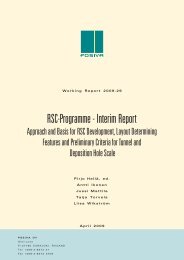Seismic 2D Reflection Processing and Interpretation of ... - Posiva
Seismic 2D Reflection Processing and Interpretation of ... - Posiva
Seismic 2D Reflection Processing and Interpretation of ... - Posiva
Create successful ePaper yourself
Turn your PDF publications into a flip-book with our unique Google optimized e-Paper software.
10Figure 5. Raw shot gather from the line S28 with automatic gain control. First nineshots on line. Trace number on X-axis <strong>and</strong> two way travel time in seconds on Y-axis.Table 2. <strong>Processing</strong> flow <strong>and</strong> parameters.<strong>Processing</strong> stepParameters1. Convert SEG2 data into SEGY (Figure 5)2. Remove noisy traces3. Set geometry4. Geometric spreading correction 1,5Multiply by t5. B<strong>and</strong>pass filter (Figure 8) 30-60-400-600 Hz6. Refraction statics (Figure 11)7. Set CDP numbers8. Deconvolution (Figure 12) Minlag: 0,01msMaxlag: 40 msStart <strong>of</strong> autocorrelation: 0 <strong>of</strong>fset: 100 ms; max<strong>of</strong>fset: 120 sEnd <strong>of</strong> autocorrelation: 0 <strong>of</strong>fset: 300 ms; max<strong>of</strong>fset: 400 msNoise: 1 %9. B<strong>and</strong>pass filter 0-100 ms: 70-140-300-450 Hz50-200 ms: 60-120-300-450 Hz150-500 ms: 50-100-270-400 Hz10. Mute (Figure 14) Linear velocity: 340 m/sWidth: 0 <strong>of</strong>fset: 10 ms; max <strong>of</strong>fset: 15 msTaper before hard mute: 1000 samples11. Automatic Gain Control (AGC) Window: 50 ms12. Residual statics (Figure 16)13. Normal Moveout (NMO) (Figure 17) Velocity: 5000 m/sStretch mute: 4Number <strong>of</strong> points to taper: 100014. Stack (Figure 21 a) )
















